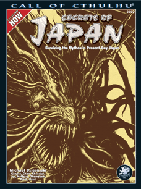
|
About OgreCave and its staff
|

|
by Demian Katz
Secrets of Japan is the first in a projected series of Call of Cthulhu supplements designed to allow Cthulhu Mythos role-playing in a Japanese setting where the Japanese people have a mystical origin and forces are converging to bring about the end of the current age of man. This introductory volume, a massive tome featuring 360 pages of smaller-than-average print, is designed for Keepers and provides enough information on the setting and its inhabitants to get a campaign started. Future volumes will add more detailed information for players and expand upon the role of the Dreamlands in Japan.
Personal Background In approaching Secrets of Japan, I hoped that it would provide rules to bring some of my favorite Japanese cultural exports into a Call of Cthulhu context while also educating me on the broader context that influenced these creations. While the work is a bit uneven at times, I was not disappointed - there's a lot crammed in here, and it's more than enough to create a whole new playground for occult investigators to explore.
Production Values
Organization I found the book's overall organization to be a bit lacking - there's no real primer or overview to give a Keeper a quick introduction to the broad themes of the book, and the work does not appear to have been designed with cover-to-cover reading in mind. References to characters, creatures and places frequently come up long before the explanations of what these characters, creatures and places actually are. On rare occasions, cross-reference page numbers are provided; sometimes, key pieces of information (mostly skills and occupations) are actually cut and pasted into multiple spots in the book. Generally, though, it's necessary to search around quite a bit to pin down all the details. Some of this could have been fixed - a better glossary would have been very valuable, and scroll two's information on tomes and magic probably belongs later in the book. On the other hand, it would be impossible to make this book totally clear on the first reading - there are quite a few different threads woven through Dziesinksi's dark vision of Japan, and it takes time and multiple readings to absorb all of them.
Not Getting Lost in Translation One complaint I have about the book (though some might find it an asset more than a liability) is that while it delves into pure fiction to augment its game information, it never steps back from the fiction and clearly states what is actual fact and what has been made up for the purposes of the setting. In the areas of historical events and belief systems (among other things), I would have appreciated better indications of where real life ends and Mythos contrivances begin. Perhaps including such boundaries would have detracted from the fluidity of the setting, but knowing the difference between real Japan and Mythos Japan could help a Keeper do better research in other sources and would increase the educational value of the book (which, for me at least, was actually a selling point).
A Dose of Controversy While I found the book's redefinition of religious ideas a little startling, one shouldn't read too much into that - it's just a small part of the book's web of Mythos associations, which put a Lovecraftian spin on all of Japanese history and culture all the way back to the creation of the Japanese people. Everything you might expect is here, and then some: stats for the radiation-breathing, city-stomping Gazira, the dark secret behind tentacle porn, suggestions for anime-style play, references to Hello Kthulhu toys... Probably the only thing missing that might be expected in an Asian-themed role-playing product is rules for martial arts combat, and they're only excluded because they're planned for inclusion in a future product.
But What's In It For My Campaign? The book includes a variety of suggestions on how to move Western characters into the Japanese setting, but it also provides alternate character creation rules for Japanese-born characters. Particularly interesting are the broad range of character occupations provided here. These diverge from the Western occupations in the core rules more than you might expect, running from radical ultra nationalists to high school students to taoist alchemists and shinto priests. Also noteworthy is the book's coverage of mental health issues unique to Japanese society. The campaign possibilities are broad and intriguing. Even if you don't intend to run a campaign set in Japan, there are plenty of elements here that could be exported to an otherwise Western-based campaign - powerful spells, bizarre and well-developed monsters like Tengu and Kappa, a whole universe of new ghostly threats, and dark tomes with long histories are all described here, and most could easily serve as the cores of entire adventures.
Starter Scenarios The second offering, "Meiro (The Labyrinth)," shows considerably more thorough development, providing enough material for three game sessions and offering advice on playing with Japanese or foreign player characters. Regardless of the players' origins, they find themselves investigating the controversial Kappa-Mon cartoon and collectible card game and becoming involved with Yotsubishi Heavy Industries, an important corporation in the Cthulhu Japan setting. By the end of the adventure, the players will have explored some dangerous locations, faced powerful adversaries, and potentially gained access to their first Mythos tome. The third full scenario, "The Yonaguni Monuments," provides the gameplay information necessary to adapt the book's opening fiction into a game scenario. This densely-written adventure follows the story quite closely, right up to its ambiguous conclusion - clearly, the intention is for the Keeper to run with the established scenario through an extended campaign. Fortunately, there are plenty of ideas provided for doing just this - the full scenarios are followed by twenty-nine brief (half-page) adventure seeds in a useful "Premise / Task / Consequence / Twists" format.
Conclusion
Links:
|
||||
 Secrets of Japan
Secrets of Japan